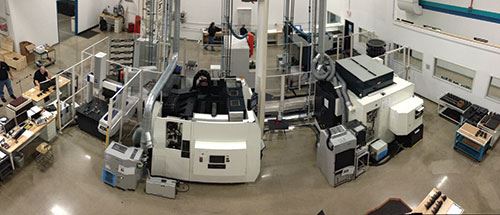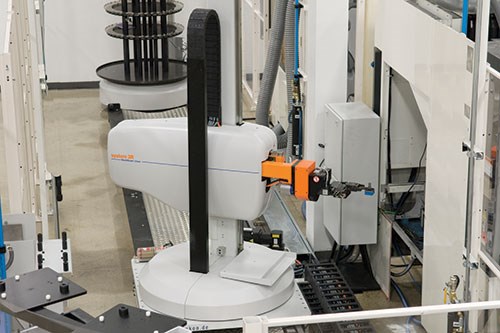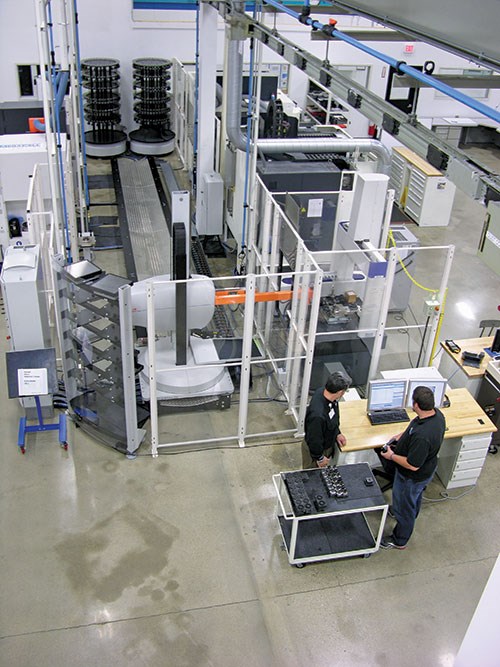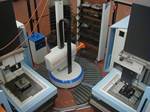Raising the Bar on Better
A look at one project to move away from traditionally customized moldmaking toward a level of complete automation that raises the bar on accuracy, repeatability and control.
Moldmakers love the idea of better. Most continually ask the same two questions: (1) “How can we build this better, more quickly, more efficiently, with less cost and effort?” and (2) “How can we build a better one?”
For Len Graham, Business Unit Leader at Rexam Mold Manufacturing (RMM) in Buffalo Grove, IL, the question of better doesn’t stop with the single part produced or with the steps taken to produce it. After 46 years in the moldmaking industry, he is working to create a new way of approaching the entire process: it’s called the Mega Cell.
Graham and his team are collaborating with companies including System 3R, Mitsubishi EDM, Solidworks, Delcam and GF AgieCharmilles, along with RMM’s dedicated team, to turn his revolutionary idea of better into a functioning reality.
At the heart of the project is a desire to move away from a traditionally customized approach to moldmaking, and toward a level of complete automation that raises the bar on accuracy, repeatability and control. “A manufacturing unit cannot effectively process the same thing being done multiple ways—although this is the norm for moldmaking as we all learned it,” Graham explains. “Each craftsman would create an end product by working on it in his own preferred way, but an automated system will freeze, or at least drastically lose efficiency, if it is fed work in that way.”
In contrast, the Mega-Cell is a production system that ties together all available opportunities to automate and control the process. “In doing this, enormous dividends are being paid not only within the more automated areas, particularly the Mega-Cell, but in all areas operating. Far fewer mistakes are made, and with strict first article inspection, any errors are found immediately and thus corrected at very low cost on whole.”
Beyond Super
The Mega-Cell has its roots in a project Graham began about a decade ago, working as Director of Tooling/Engineering with Tech Group’s C/EC Division in Scottsdale, AZ, on what was then called the Super-Cell. While that project generated a lot of industry interest, it never quite reached completion before the company was sold; the technology available at the time had not caught up with the idea.
The same companies that originally supported that project are on board for the Mega-Cell. “We have a lot more bullets for our gun this time,” Graham says. “The idea can be viewed as a process patent—a way to do something unique. This version is a variation of that process, but updated to the technology available today.”
When complete in about five to six years, the Mega-Cell will be the world’s first fully automated mold manufacturing system. It will consist of two automated manufacturing systems: a rail system on one side of the shop for manufacturing mold inserts, and machining centers and a larger-capacity rail system on the other side for manufacturing mold plates.
The mold insert manufacturing rail system will have five rails, each approximately 30 feet long; each will have one robot feeding five or six pieces of equipment. Each rail will have a CMM to verify and track all critical-to-function dimensions on pallet-mounted mold components and electrodes, and all machining disciplines needed to manufacture these components will be represented on the line—plans include high-speed machining centers, jig grinders, surface grinders, laser engravers, and more, all robot-ready.
Component carousels will pass components from one rail to another and back again as required to keep all machines operating efficiently. Rotary carousels and bookshelves are in place to carry small, medium and larger sized mold components. The robot can automatically change arms/hands to facilitate changing different style pallets to carry the components. Pallet sizes range from 2 1/8 sq. in. (the smallest) to 12 sq. in. (the largest.)
Smaller pallets go into the machines on a robot switch-arm that can take one pallet in and remove one from the machine in one trip. Each pallet includes an embedded radio-frequency (RF) chip; a technician scans the chip, identifies the piece on the pallet, and assigns the machining programs/work being done to it for processing and inspecting. The center of all design, programming, manufacturing, and inspection is a pallet-mounted high-precision gage ball. Each component has a single point of reference that is consistent with all machines and inspection associated with it on the line.
After the mold insert/electrode manufacturing unit is complete on one side of the shop, it goes to the other side, where there will be horizontal machining centers and a larger capacity rail system for manufacturing the mold plates for the mold bases. This system will use the same auto-locating feature as the mold insert manufacturing unit, with the palletized gage ball.
“The idea in both scenarios is to be able to place a workpiece into a machine robotically and begin machining and inspecting without the need to use probing or some other ancillary means of finding it before machining/inspecting can begin,” Graham explains.
“We simply use the solid models of the components associated to the component receivers/holders. All mold plates will join the mold components on the same end of the shop for assembly on the benches. Assembly benches are just outside the mold sampling room, so that everything moves in one direction until becoming a completed, sampled and shipped mold tool.”
Customers and Collaborators
The Mega-Cell is monitored with cameras and machine controls provide Internet access; this allows customers to see and monitor the work being done on their mold components, and to view inspection reports for every detail as long as their work remains in the machines. “Customers have always wanted three main things from their moldmakers: molds built with the lowest practical cost, delivered sooner and of the highest quality— most consistent across all dimensions for all cavities achievable,” Graham says. “The Mega-Cell can run 24/7; it runs much of the time untended, without labor cost; and consistency is the operative word, as it will do the same thing, the same way, throughout an entire series of parts, without varying the process. Of course the cost savings is the last to be realized due to the high cost of development and the time needed to fully realize the benefit, both in time and dollars, of the investment.”
Fortunately, when Graham arrived at Rexam almost 18 months ago, he found a team ready and willing to make that investment. “I told them that if we were going to do this, I would need them to work very hard to fill in the wide technology and systemic gaps, since this would be the first of its kind. This team has far exceeded my wildest expectations.”
The most difficult aspect of the transformation from an old-style mold shop into a fully automated mold manufacturing unit is developing the complete standardization that is necessary for success. During the year prior to installing Rail #1, each area of discipline (moldmakers, EDM specialists, CNC machinists and programmers, mold designers, grinding specialists and tooling engineers) held weekly continuous improvement meetings to establish one preferred way of performing every single task. Teams set standards for every operation strategy for every area, as well as for every operation or duty.
“Standards/procedures manuals are being developed for every department; no one can work in the area without reading and understanding the content of the manual,” says Graham.
The RMM team is not the only group on board with the Mega-Cell’s potential. “Something this exciting draws the major players like flies,” Graham reports. “Everyone wants to be associated with this project as it is poised to move American mold manufacturing into and even beyond the world-recognized, high quality arena that is widely known to exist in Europe. Mega-Cell partners represent all the technologically advanced manufacturing countries in the world. We will be happy to be able to say, ‘Hey, we have an advanced system that gives us the ability to engineer and build a pretty darn great mold here in the U.S. too.’
“The customers have set the bar and it is up to us to clear it,” he concludes. “I am not talking about RMM alone, but mold manufacturing on the whole. In the not-so-distant future, if a mold shop of stature does not make the transition away from custom moldmaking to systematic mold manufacturing, there can’t be much room for growth – and that shop’s survival will come into question, if they try to compete at this high a level.”
For More Information:
Rexam Mold Manufacturing
www.rexam.com/mold
Related Content
Mold Builder Meets Increased Domestic Demand With Automated Cells
Burteck LLC experienced significant demand increases due to reshoring and invested in automated machining cells to step up its production output quickly and avoid losing business.
Read MoreFive-Axis Graphite Mill With Automation Debottlenecks Electrode Machining
Five-axis electrode cutting enabled Preferred Tool to EDM complex internal screw geometry on an insert that otherwise would have had to be outsourced.
Read MoreMMT Chats: 4 Keys to a Successful Mold-Building Operation: Innovation, Transparency, Accessibility and Relationship
MoldMaking Technology Editorial Director Christina Fuges chats with Steve Michon, co-owner of Zero Tolerance in Clinton Township, Michigan, about the excitement of solving problems, the benefits of showing gratitude, the real struggle with delegation and the importance of staying on top of technology. This episode is brought to you by ISCAR with New Ideas for Machining Intelligently.
Read MoreMaintaining a Competitive Edge: EDM, Automation and Machining Technology Roundup
This month’s technology roundup features products, processes and services relating to EDM, automation and machining. For example, jig grinding for large molds, scheduling automation software, cobot integration, die sinker EDM and much more.
Read MoreRead Next
An Innovative Approach to Employee Training
This mold manufacturer looked within its own talent pool to develop—and implement—a new apprenticeship program to address the skilled workforce challenge.
Read MoreAutomation Advancements Streamline Mold Manufacturing
Implementing new technologies across the entire shop floor improves overall accuracy, productivity and profitability.
Read MoreReasons to Use Fiber Lasers for Mold Cleaning
Fiber lasers offer a simplicity, speed, control and portability, minimizing mold cleaning risks.
Read More



















.jpg;maxWidth=300;quality=90)
_300x250 3.png;maxWidth=300;quality=90)










